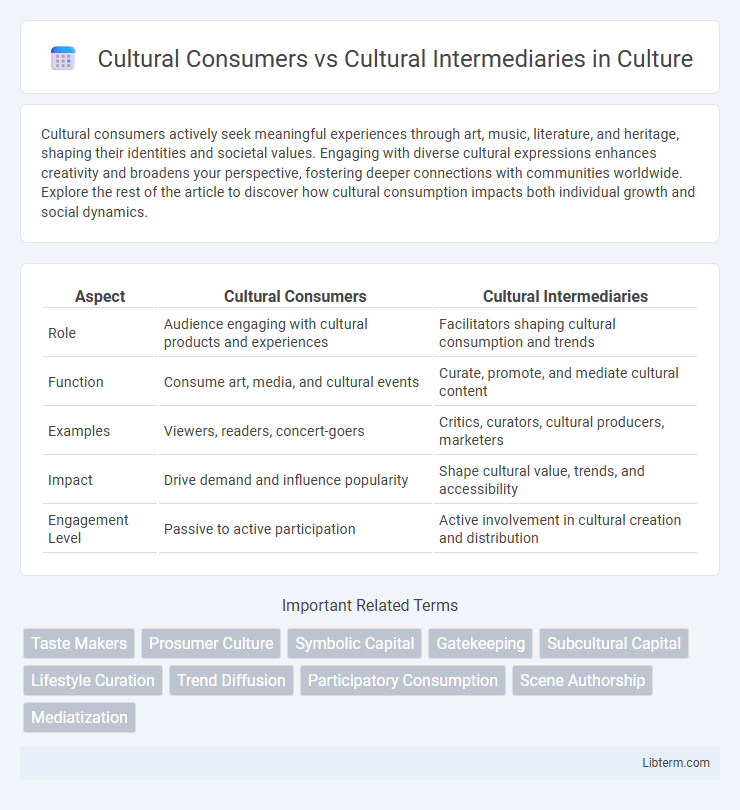Cultural consumers actively seek meaningful experiences through art, music, literature, and heritage, shaping their identities and societal values. Engaging with diverse cultural expressions enhances creativity and broadens your perspective, fostering deeper connections with communities worldwide. Explore the rest of the article to discover how cultural consumption impacts both individual growth and social dynamics.
Table of Comparison
| Aspect | Cultural Consumers | Cultural Intermediaries |
|---|---|---|
| Role | Audience engaging with cultural products and experiences | Facilitators shaping cultural consumption and trends |
| Function | Consume art, media, and cultural events | Curate, promote, and mediate cultural content |
| Examples | Viewers, readers, concert-goers | Critics, curators, cultural producers, marketers |
| Impact | Drive demand and influence popularity | Shape cultural value, trends, and accessibility |
| Engagement Level | Passive to active participation | Active involvement in cultural creation and distribution |
Understanding Cultural Consumers: Who They Are
Cultural consumers are individuals who actively engage with cultural products such as art, music, literature, and films, shaping market demand through their preferences and consumption patterns. They often seek experiences that align with personal identity, social status, and emotional fulfillment, influencing trends and cultural value. Understanding their demographic diversity, motivations, and consumption contexts is essential for effectively targeting and developing cultural markets.
Defining Cultural Intermediaries: Roles and Influence
Cultural intermediaries are professionals who shape cultural consumption by mediating between producers and consumers, often including critics, curators, marketers, and media. Their influence lies in framing cultural products' value, guiding consumer tastes, and legitimizing artistic expressions through interpretation and promotion. By controlling access to cultural goods and shaping public perception, cultural intermediaries significantly impact market trends and cultural capital distribution.
Key Differences Between Consumers and Intermediaries
Cultural consumers actively engage with and interpret cultural products, prioritizing personal meaning and experiential value, whereas cultural intermediaries act as gatekeepers who influence cultural consumption through curation, critique, and mediation. Consumers seek authentic experiences and emotional connections, while intermediaries focus on shaping tastes, trends, and market dynamics by selecting and promoting cultural goods. The key difference lies in consumers' role as recipients of culture versus intermediaries' role as facilitators who frame and guide cultural consumption.
Evolution of Cultural Consumption in the Digital Age
Cultural consumption has evolved dramatically in the digital age, shifting from passive engagement by cultural consumers to active participation mediated by cultural intermediaries such as influencers, curators, and platforms. These intermediaries shape cultural narratives and trends by filtering, interpreting, and distributing content across digital networks, amplifying personalized experiences and niche interests. Data analytics and algorithm-driven recommendations have further transformed consumption patterns, enabling dynamic interactions between creators, intermediaries, and audiences in a globalized cultural ecosystem.
The Power of Curation: Intermediaries as Tastemakers
Cultural intermediaries wield significant influence as tastemakers by curating and shaping consumer preferences through selective promotion of art, fashion, and media. Their expertise and authority in filtering cultural content enable them to create trends and assign value, guiding the cultural consumption patterns of audiences. By mediating between producers and consumers, intermediaries construct cultural hierarchies that define what is considered fashionable, desirable, or prestigious.
Social Media and the Democratization of Culture
Social media platforms have transformed cultural consumption by enabling cultural consumers to actively engage, share, and create content without relying solely on traditional cultural intermediaries like critics or curators. This democratization of culture empowers individuals to influence trends and shape cultural narratives directly through platforms such as Instagram, TikTok, and Twitter. The shift diminishes the gatekeeping power of intermediaries, fostering a more decentralized and participatory cultural landscape.
Gatekeeping: Traditional vs Contemporary Intermediaries
Traditional cultural intermediaries, such as critics, curators, and editors, functioned as gatekeepers by controlling access to cultural products and shaping public taste through centralized platforms like print media and galleries. Contemporary intermediaries, including social media influencers, bloggers, and algorithm-driven platforms, democratize gatekeeping by enabling diverse voices and user-generated content to influence cultural consumption dynamically. The shift reflects a decentralized, participatory model where algorithmic curation and peer networks redefine authority and gatekeeping power in the cultural marketplace.
Impact of Cultural Trends on Consumer Behavior
Cultural consumers drive market demand by adopting emerging trends, influencing purchasing decisions through preferences shaped by social values and identity. Cultural intermediaries, such as critics, curators, and influencers, act as gatekeepers who interpret and mediate cultural trends, shaping consumer perceptions and legitimizing new styles or products. Their role in amplifying or filtering trends significantly impacts consumer behavior, creating feedback loops that accelerate or dampen market adoption.
Challenges Facing Modern Cultural Intermediaries
Modern cultural intermediaries face challenges such as adapting to rapidly evolving digital platforms and shifting consumer behavior patterns driven by social media influence. They must navigate the tension between maintaining authentic cultural value and responding to commercial pressures from market demands. Additionally, balancing the roles of content curation, promotion, and critical evaluation requires continuous innovation to remain relevant in an increasingly saturated cultural landscape.
Future Outlook: Shifting Dynamics in Cultural Mediation
Cultural consumers are increasingly influencing cultural production through digital platforms, reshaping demand patterns and content creation processes. Cultural intermediaries, such as critics, curators, and marketers, must adapt by integrating data analytics and engaging with online communities to maintain relevance. The future of cultural mediation hinges on dynamic interactions between consumer-driven trends and intermediaries' evolving roles in shaping cultural narratives.
Cultural Consumers Infographic

 libterm.com
libterm.com